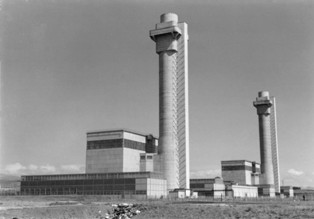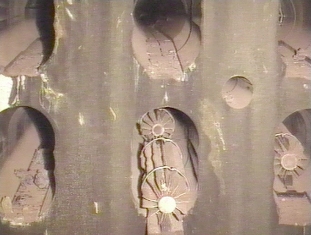The first of the two reactor piles at the military facility was damaged beyond repair by a fire that officially began on 10 October 1957. After many hours it was finally extinguished by flooding with water. Most of the radionuclides released from burning nuclear fuel were caught by filters on the top of the pile's chimney, but some escaped and travelled in a plume across Britain. The other reactor pile was not operated after the accident, which was at the time the world's worst.
In the late 1950s and early 1960s the piles and chimneys were sealed, had their filters removed and redundant equipment taken away. The highly radioactive used nuclear fuel and isotope cartridges were removed from Pile 2, but some in Pile 1 had been badly damaged by the fire. Between 1980 and 1999 much work was undertaken to put the pile 1 in a safe condition for further decommissioning.
Very high levels of radioactivity surrounding the damaged nuclear fuel make it difficult to examine, and methods to remove it by remote control have had to be developed on extremely pessimistic assumptions. However, with the plant in a safe condition state custodian UKAEA has been able to develop the advanced techniques it needs to eventually demolish the building.
Today, the core of Pile 1 still contains about 10% of its nuclear fuel. UKAEA plan to cut through the top of the reactor's reinforced concrete cap and shield to deploy tools and manipulators on both sides of the horizontal fuel rods and remove the damaged fuel and isotope cartridges. Shutdown and control rods will be removed from both piles and reactor internal materials will be removed remotely. The graphite blocks that form the pile itself will be removed in bulk where possible. After the reactor core is removed, the remaining internal surfaces of the reactor will be removed or decontaminated prior to final demolition of the biological shield.
Further information
UKAEA
The Windscale accident In the aftermath of World War II, the British government saw thedevelopment of a nuclear deterrent as vital and an ambitious plan waslaunched to test a weapon by 1952. The Windscale piles, built on thecoast of Cumbria in north-western England, were built to produceplutonium for the weapons program at a time when nuclear materialsproduction was in its infancy. In the aftermath of World War II, the British government saw thedevelopment of a nuclear deterrent as vital and an ambitious plan waslaunched to test a weapon by 1952. The Windscale piles, built on thecoast of Cumbria in north-western England, were built to produceplutonium for the weapons program at a time when nuclear materialsproduction was in its infancy. In 1952 scientists operating the piles noticedunexpected temperature rises in both Windscale reactors caused bypockets of so-called Wigner energy becoming trapped in the lattice ofthe core. To release the energy andcontinue operation, an annealing process involving gradually heating the core above normal temperatures wasdeveloped, but this process became more difficult over time and was notfully understood.  Pile 1's ninth annealing operation began on 7 October 1957 but got out of control as Wigner energy caused runaway heating. By 10 October a fire was observed in the nuclearfuel channels. Filters on the tops of the facility's cooling chimneys prevented most of the radioactive materialsreleased from escaping, but nevertheless a large amounttravelled across Britain and northern Europe. Pile 1's ninth annealing operation began on 7 October 1957 but got out of control as Wigner energy caused runaway heating. By 10 October a fire was observed in the nuclearfuel channels. Filters on the tops of the facility's cooling chimneys prevented most of the radioactive materialsreleased from escaping, but nevertheless a large amounttravelled across Britain and northern Europe.After many hours, the fire was brought under control by flooding the core with water and turning off cooling fans to starve the fire of oxygen. Pile 2 was then closed down also. No-one was directly hurt by the accident, but many studies since 1957 have attempted to evaluate the impact of the radioactive plume on the environment, with a wide range of estimates of extra cancer cases and cancer deaths. However, all estimates are dogged by uncertainty because of the difficulty in determining precise effects. Indeed, a newly published study, based on meteorological data, suggests that the plume may have extended further eastwards than previously thought. |




_18570.jpg)
_18938.jpg)
_33584.jpg)
_82983.jpg)





